NVIDIA’s GeForce GTX 480 and GTX 470: 6 Months Late, Was It Worth the Wait?
by Ryan Smith on March 26, 2010 7:00 PM EST- Posted in
- GPUs
Image Quality & AA
When it comes to image quality, the big news from NVIDIA for Fermi is what NVIDIA has done in terms of anti-aliasing of fake geometry such as billboards. For dealing with such fake geometry, Fermi has several new tricks.
The first is the ability to use coverage samples from CSAA to do additional sampling of billboards that allow Alpha To Coverage sampling to fake anti-alias the fake geometry. With the additional samples afforded by CSAA in this mode, the Fermi can generate additional transparency levels that allow the billboards to better blend in as properly anti-aliased geometry would.
The second change is a new CSAA mode: 32x. 32x is designed to go hand-in-hand with the CSAA Alpha To Coverage changes by generating an additional 8 coverage samples over 16xQ mode for a total of 32 samples and giving a total of 63 possible levels of transparency on fake geometry using Alpha To Coverage.
In practice these first two changes haven’t had the effect we were hoping for. Coming from CES we thought this would greatly improve NVIDIA’s ability to anti-alias fake geometry using cheap multisampling techniques, but apparently Age of Conan is really the only game that greatly benefits from this. The ultimate solution is for more developers of DX10+ applications to enable Alpha To Coverage so that anyone’s MSAA hardware can anti-alias their fake geometry, but we’re not there yet.
So it’s the third and final change that’s the most interesting. NVIDIA has added a new Transparency Supersampling (TrSS) mode for Fermi (ed: and GT240) that picks up where the old one left off. Their previous TrSS mode only worked on DX9 titles, which meant that users had few choices for anti-aliasing fake geometry under DX10 games. This new TrSS mode works under DX10, it’s as simple as that.
So why is this a big deal? Because a lot of DX10 games have bad aliasing of fake geometry, including some very popular ones. Under Crysis in DX10 mode for example you can’t currently anti-alias the foliage, and even brand-new games such as Battlefield: Bad Company 2 suffer from aliasing. NVIDIA’s new TrSS mode fixes all of this.

Bad Company 2 DX11 Without Transparency Supersampling
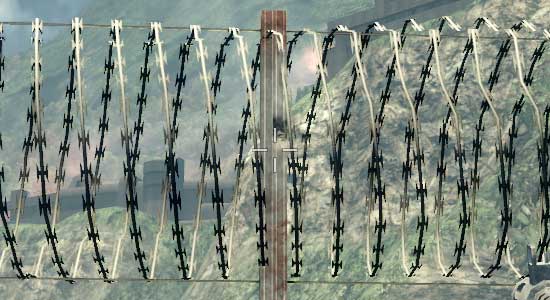
Bad Company 2 DX11 With Transparency Supersampling
The bad news is that it’s not quite complete. Oh as you’ll see in our screenshots it works, but the performance hit is severe. It’s currently super-sampling too much, resulting in massive performance drops. NVIDIA is telling us that this should be fixed next month, at which time the performance hit should be similar to that of the old TrSS mode under DX9. We’ve gone ahead and taken screenshots and benchmarks of the current implementation, but keep in mind that performance should be greatly improving next month.
So with that said, let’s look at the screenshots.

| NVIDIA GeForce GTX 480 | NVIDIA GeForce GTX 285 | ATI Radeon HD 5870 | ATI Radeon HD 4890 |
| 0x | 0x | 0x | 0x |
| 2x | 2x | 2x | 2x |
| 4x | 4x | 4x | 4x |
| 8xQ | 8xQ | 8x | 8x |
| 16xQ | 16xQ | DX9: 4x | DX9: 4x |
| 32x | DX9: 4x | DX9: 4x + AAA | DX9: 4x + AAA |
| 4x + TrSS 4x | DX9: 4x + TrSS | DX9: 4x + SSAA | |
| DX9: 4x | |||
| DX9: 4x + TrSS |
With the exception of NVIDIA’s new TrSS mode, very little has changed. Under DX10 all of the cards produce a very similar image. Furthermore once you reach 4x MSAA, each card producing a near-perfect image. NVIDIA’s new TrSS mode is the only standout for DX10.
We’ve also include a few DX9 shots, although we are in the process of moving away from DX9. This allows us to showcase NVIDIA’s old TrSS mode, along with AMD’s Adapative AA and Super-Sample AA modes. Note how both TrSS and AAA do a solid job of anti-aliasing the foliage, which makes it all the more a shame that they haven’t been available under DX10.
When it comes to performance, keep in mind that both AMD and NVIDIA have been trying to improve their 8x MSAA performance. When we reviewed the Radeon 5870 back in September we found that AMD’s 8x MSAA performance was virtually unchanged, and 6 months later that still holds true. The performance hit moving from 4x MSAA to 8x MSAA on both Radeon cards is roughly 13%. NVIDIA on the other hand took a stiffer penalty under DX10 for the GTX 285, where there it fell by 25%. But now with NVIDIA’s 8x MSAA performance improvements for Fermi, that gap has been closed. The performance penalty for moving to 8x MSAA over 4x MSAA is only 12%, putting it right up there with the Radeon cards in this respect. With the GTX 480, NVIDIA can now do 8x MSAA for as cheap as AMD has been able to
Meanwhile we can see the significant performance hit on the GTX 480 for enabling the new TrSS mode under DX10. If NVIDIA really can improve the performance of this mode to near-DX9 levels, then they are going to have a very interesting AA option on their hands.
Last but not least, there’s anisotropic filtering quality. With the Radeon 5870 we saw AMD implement true angle-independent AF and we’ve been wondering whether we would see this from NVIDIA. The answer is no: NVIDIA’s AF quality remains unchanged from the GTX200 series. In this case that’s not necessarily a bad thing; NVIDIA already had great AF even if it was angle-dependant. More to the point, we have yet to find a game where the difference between AMD and NVIDIA’s AF modes have been noticeable; so technically AMD’s AF modes are better, but it’s not enough that it makes a practical difference
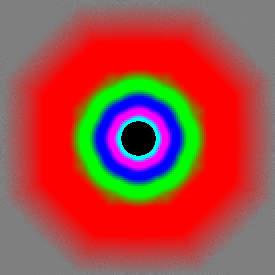
GeForce GTX 480

GeForce GTX 285
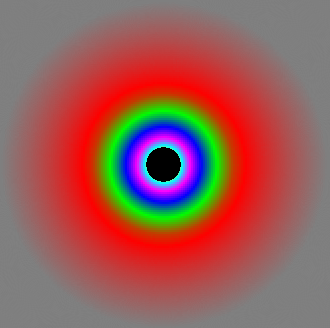
Radeon 5870


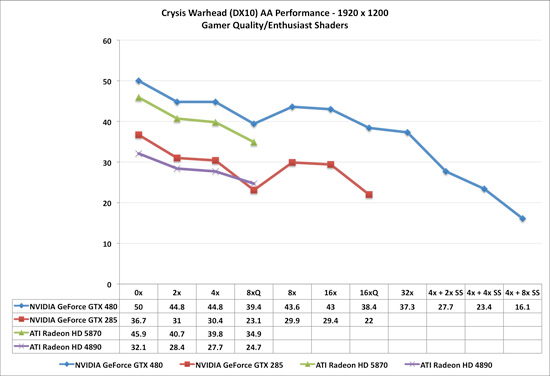
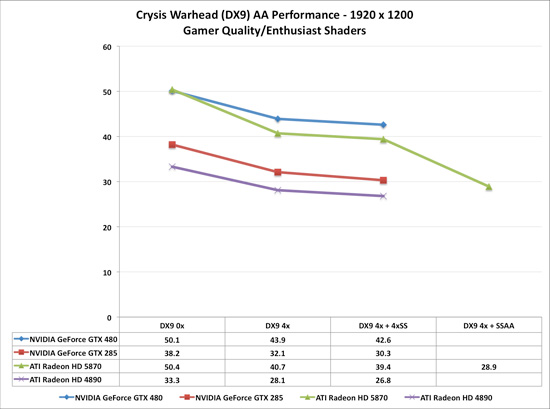








196 Comments
View All Comments
GTaudiophile - Saturday, March 27, 2010 - link
Me thinks that Cypress really blindsided nVidia. And then on top of it being such an efficient chip, you throw in Eyefinity and all of the audio over HDMI features, etc.Talk about a smack down.
AnnihilatorX - Saturday, March 27, 2010 - link
Page 2:Finally we bad news: availability. This is a paper launch;
simtex - Saturday, March 27, 2010 - link
With the current console generation being the primary focus of game developers I find it hard to believe that tessalation will get the big breakthrough anytime soon. With the next-gen console, it will come, but that is few years from now, and hopefully at that time we have seen at least one new generations of GPUs.viewwin - Saturday, March 27, 2010 - link
I would like a test to see how the new cards do at video encoding.Philip123 - Saturday, March 27, 2010 - link
These things are not "single slot cards" They are double slot. They take 2 slots. No review should be published without pointing out performance per watt. If you dont publish performance per dollar which includes the 100 watt premium over 3 years you are not doing your job. Only and idiot would buy anything from nvdia. You really think anyone is going to want fan noise from these monstrosities anywhere near them?SHAME SHAME SHAME.
Throw this bullshit in the garbage and tell nvidia to f-off untill it releases an actual computer graphics product instead of a spaceheater for retarded monekeys with developmental disablities.
AnnonymousCoward - Saturday, March 27, 2010 - link
You are so wrong.You talk about dual-slot cards as if it's a bad thing--it's the best design currently possible, since it allows for efficient cooling without much fan noise, and the heat goes outside your case. Plus, AMD's 5870 & 5850 are also dual slot!
"No review should be published without pointing out performance per watt" - what gamer cares about that? That's a concern for server farmers!
529th - Saturday, March 27, 2010 - link
I think people would be interested in seeing these cards overclocked, also seeing the 470 in SLIcobra32 - Saturday, March 27, 2010 - link
So Nvidia's fastest card is 11% faster than AMD's mid level card 5870 and AMD's top card the 5970 is allot faster than the 480 GTX. Do not give me that the 5970 is a two chip card and cannot be compared to a single chip card. Sorry guys the 5970 takes up one slot just like the 480 GTX and is faster and consumes less energy to move things on the screen faster. If I got 3 slots on my motherboard I can have 6 video chips with an ATI while with a nvidia setup I can have only 3 at the most. Until Nvidia has a two chip version which looks impossible with this power hunger design. ATI has the top single card, be that two chips, you can buy. It took them 6 months and still cannot buy one paper launches suck. I have bought several Nvidia Cards and like them all but this one really looks to fall short. If I got one slot to put my video card in, ATI has the highest performing Card I can buy 5970. It's like this would I rather have a single core chip or dual core cpu and that's a no brainer two is always better than one.
Roland00 - Saturday, March 27, 2010 - link
Two thingsYou can only have 4 gpus in nvidia or ati multi gpu setups. That means two 5970s not 3. (well you can have 4 gpus and one physX)
Second crossfire doesn't scale well past 2 cards, sli doesn't scale well past 3.
derrida - Saturday, March 27, 2010 - link
Thank you Ryan for including OpenCL benchmarks.